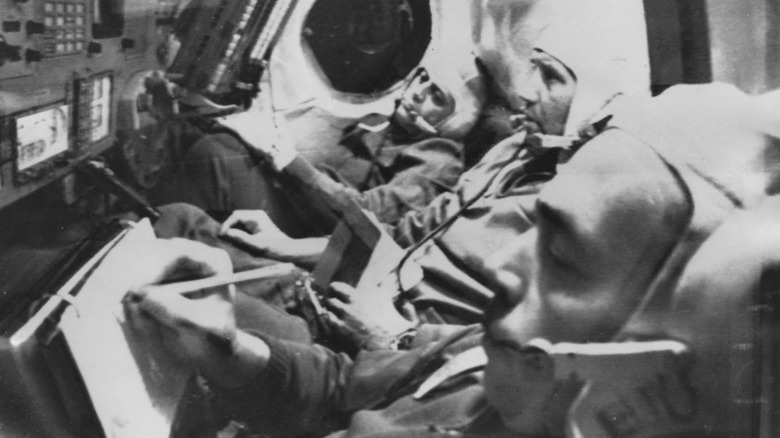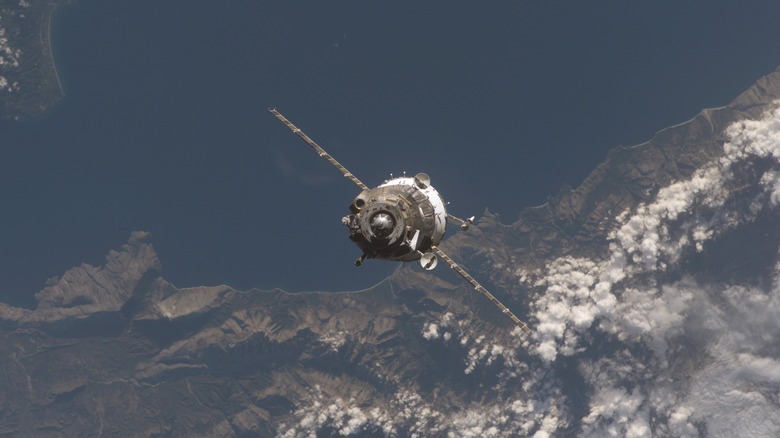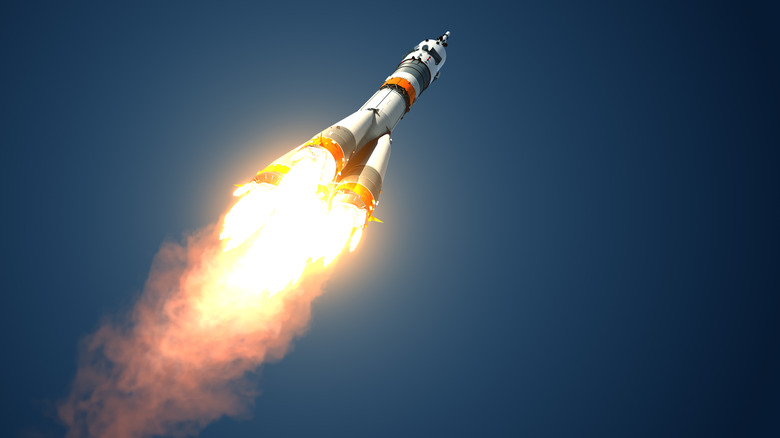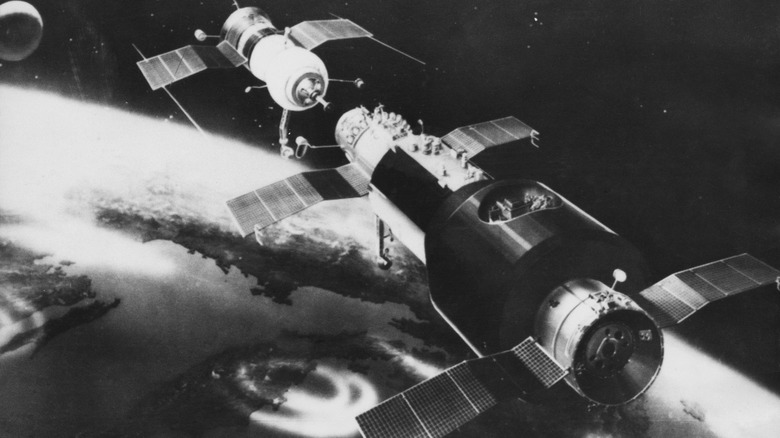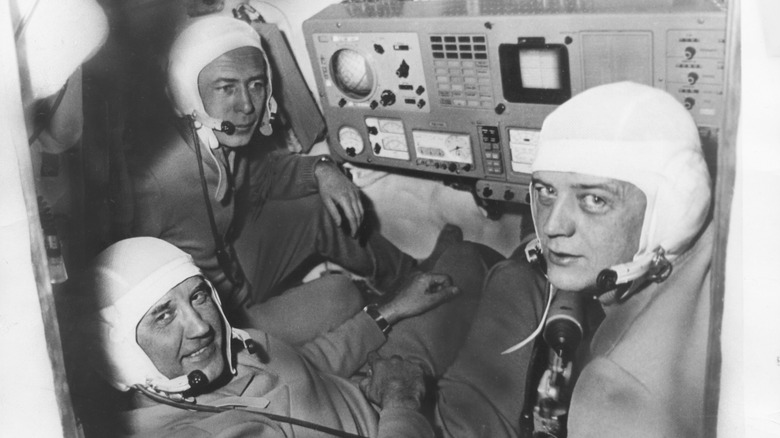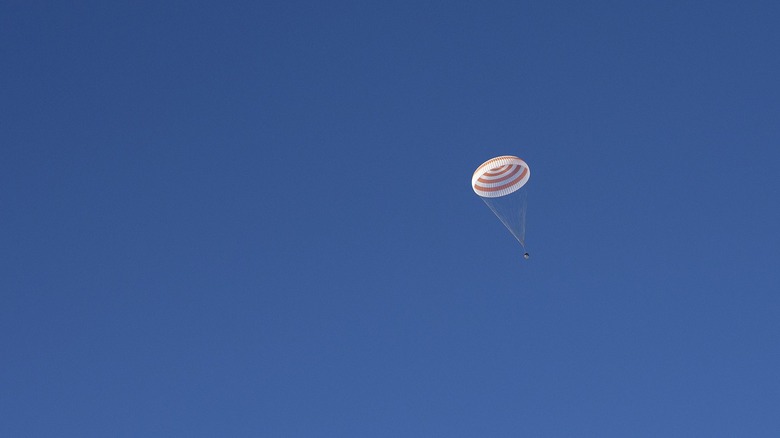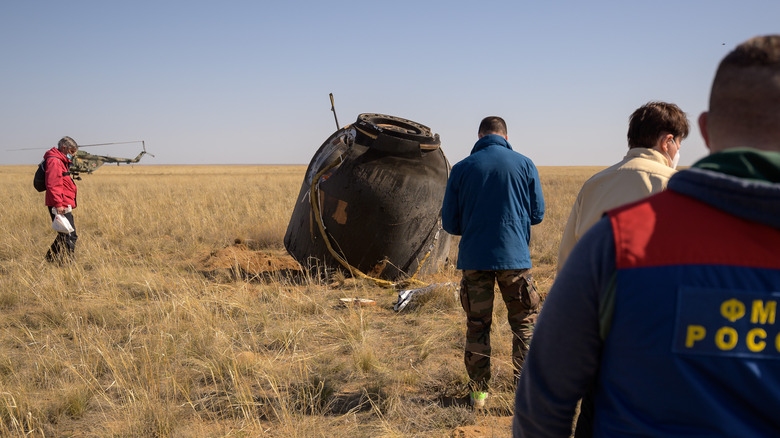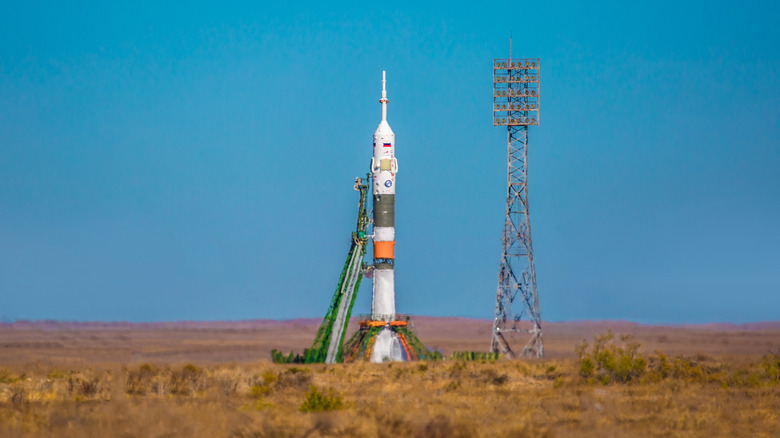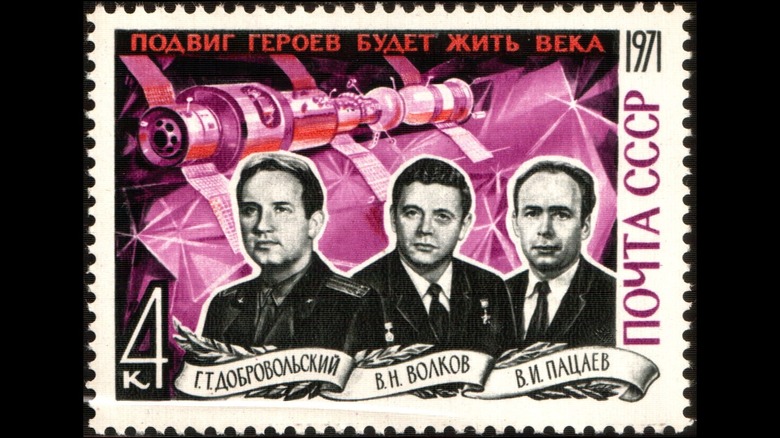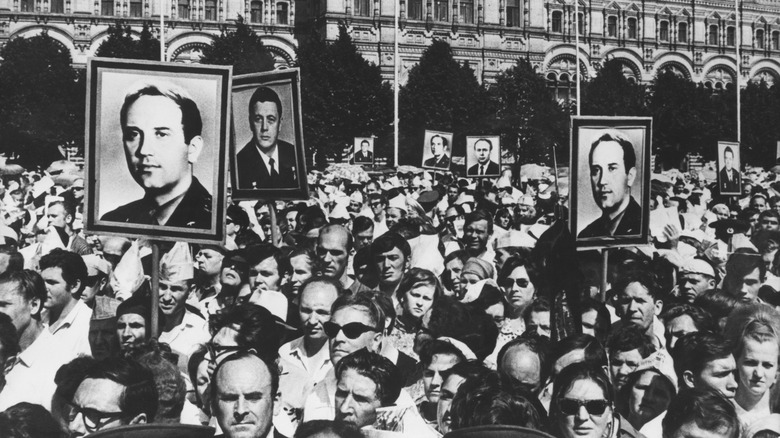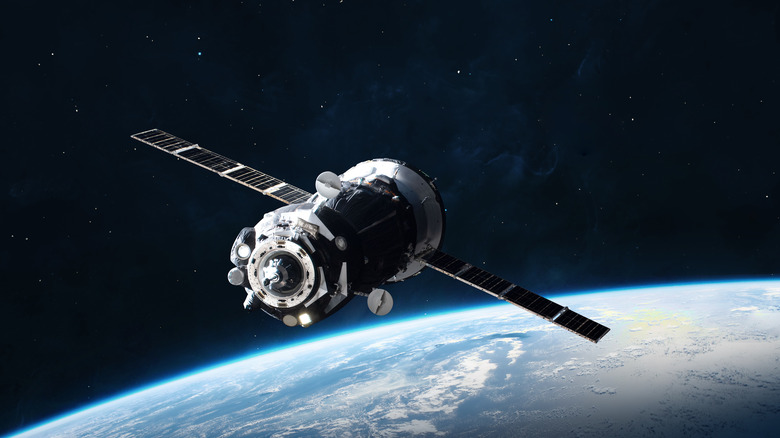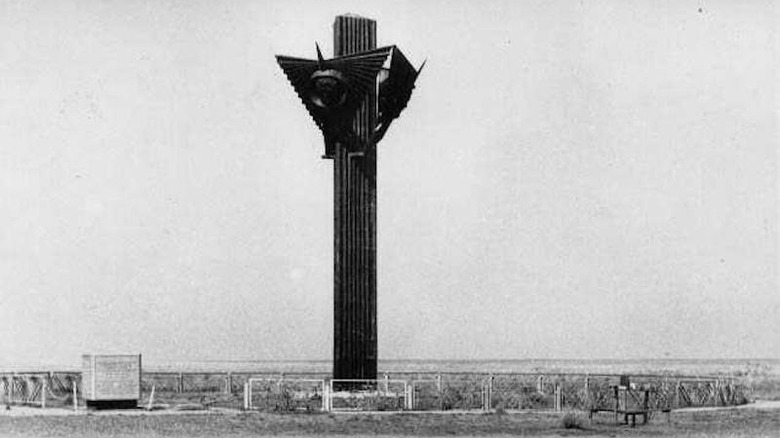The Tragic Story Of Soyuz 11, The Only Astronaut Fatalities In Space
Space travel is notoriously dangerous. The vacuum of space, outside the protection of Earth's atmosphere, is hazardous to humans in all kinds of unpleasant ways, from risks from cosmic radiation to powerful solar ultraviolet light. The most dangerous thing about space, however, is space itself. The human body simply isn't equipped to handle exposure to vacuum-like environments and, as Scientific American explains, while the reality may be less dramatic than the portrayals in movies, exposure to these vacuum conditions will kill a person in about two minutes.
In a way, it's remarkable that space has claimed so few victims in human history, and this stands as a testament to how careful and safety-conscious space agencies like NASA, JAXA, and Roscosmos have been over the years. This isn't to say that space travel has been free of incidents, however. There have been several disasters in space history (some fatal), and Scientific American also notes that spacecraft are, in many ways, just as sensitive and fragile as the humans traveling inside them. Some astronauts out in space have had some perilously close calls in the past.
To date though, only three humans have ever actually died in space. Per Astronomy Magazine, their names were Georgi Dobrovolski, Vladislav Volkov, and Viktor Patsayev. These three Soviet cosmonauts were the crew of the ill-fated Soyuz 11 mission in 1971, a space mission that would ultimately prove to be both historic and catastrophic.
The 11th of a long line
The Soyuz program is one of the great success stories of human spaceflight. As ESA explains, it is, in many ways, the most successful space program in human history. With its Russian name translating to "Union" in English, the Soyuz program began in 1967 and continues to this very day, outlasting both NASA's Apollo and Space Shuttle programs. Over more than half a century, Soyuz vehicles have had many alterations and upgrades, but in many ways, they're essentially the same spacecraft they always have been.
Soyuz spacecraft were first used at a pivotal time during the Space Race. Per Royal Museums Greenwich, the big goal in the late 1960s was to land humans on the Moon, a feat that NASA accomplished in 1969. Following America's success, the Soviet Union abandoned its plans to send its own cosmonauts to the Moon, choosing to focus instead on space stations orbiting the Earth. In 1971, Soyuz 11 would play a vital role as proof that humans could survive in orbit for extended periods of time, solidifying the old Soviet dream of placing semi-permanent outposts in space. The early groundwork laid down by this mission would later pave the way for the International Space Station, a grand collaboration between spacefaring nations which is still in orbit around Earth today. But things would not go smoothly for the Soyuz 11 mission. It would turn out to be a troubled endeavor, with a host of difficulties before its unfortunate end.
The crew who weren't
The first sign of trouble for the Soyuz 11 mission concerned its crew. The Soviet space program kept a backup crew in reserve for each mission and was careful to ensure that its crew would be in full health. Per Astronomy Magazine, the original crew for Soyuz 11 were veteran spacefarers. The star of the mission was Alexei Leonov, a famous cosmonaut and the first person in history to successfully perform a spacewalk. There was good reason for everyone involved to be optimistic.
Unfortunately, barely three days before Soyuz 11 was due to fly, doctors raised health concerns for Leonov. They suspected he may have tuberculosis, and the original crew was all grounded. Leonov's condition would turn out to be a mere pollen allergy, but it was too late. Mission control had already made a final decision to send the backup crew instead. While this was a crushing blow for Leonov and his team, Space Safety Magazine notes that it was no less difficult news for the replacements. Inexperienced and deeply nervous at the sudden change in plans, they'd only been in training for four months at the time. Two had no prior spaceflight experience at all, and the only one who'd flown before had no experience in docking maneuvers. With barely any notice, a team of newbie cosmonauts was faced with the intimidating task of taking on what would be the longest space mission in human history so far.
The troubled Salyut 1 space station
Many people have grown up with the International Space Station in orbit around our planet. It's been there since the first of its many modules was launched in 1998, so it's easy to forget that, in the late 20th century, nothing like it had existed before. In 1971, per NASA, any kind of space station was utterly unheard of. When Salyut 1 was launched, its pioneering engineering was the first of its kind, designed to last only six months before falling back into Earth's atmosphere and crash landing into the ocean. In the end, Salyut 1 would only ever host one crew.
The first visitors to Salyut 1 were the crew of Soyuz 10, though their mission would not go according to plan. According to NASA's Office of Safety and Mission Assurance, Soyuz 10 visited for only five and a half hours. They failed to properly dock with the space station, were unable to enter because of a malfunctioning door on their own vehicle, and then had difficulty decoupling their spacecraft from the station, needing several attempts to get free. Everything that could go wrong seemingly did go wrong on this abortive visit to Salyut 1, and their troubles didn't end in orbit. During landing, Soyuz 10 had trouble with a toxic air supply, rendering one cosmonaut unconscious on return to Earth. In hindsight, this whole ordeal seems almost like a bad omen for what was to come.
Salyut 1's only crew
The three cosmonauts of Soyuz 11 would end up being the only people to ever inhabit Salyut 1. As NASA notes, following the failures of Soyuz 10, the Soyuz 11 vehicle had a few hasty redesigns to avoid any further problems docking with the space station. The improvements evidently worked, allowing Soyuz 11 to dock with Salyut 1, but it was a slow process. According to a NASA summary of the mission, the entire docking procedure took over three hours, requiring mechanical, electrical, and hydraulic connections to be made, and an airtight seal to be established before the doors could be opened. While doubtless a tiring procedure, things were going according to plan.
The time spent on Salyut 1, however, would not be without difficulties. One notable problem is mentioned in the book, "The First Space Station," which mentions that Salyut 1 included a treadmill to keep the cosmonauts healthy while in microgravity. Unfortunately, using it for exercise caused vibrations to rattle the entire space station, causing solar panels on the exterior to flex worryingly. Mission control advised to use it sparingly as a result. A more serious problem was an electrical fire, which nearly caused the crew to abandon the station early. This was further compounded by the panic-stricken cosmonauts using code words, according to their instructions, in case American eavesdroppers intercepted their signals — but Soviet mission control seemingly forgot what those code words meant!
A doomed return journey
Despite all the trouble so far, when the time came for the crew of Soyuz 11 to return to Earth, they were feeling optimistic, per "The First Space Station," being proud of their accomplishments during the mission. And with good reason. They'd now spent longer in space than any other astronauts before them. One cosmonaut even quipped with mission control as they were leaving Salyut 1 that they should keep the cognac ready to celebrate their safe return. (Cognac was a traditional victory drink for returning cosmonauts at the time.) Tragically though, there would be no safe return and no cognac.
According to Astronomy Magazine, the disastrous events unraveled with alarming speed. While still around 100 miles above Earth, a set of explosive charges fired on the Soyuz vehicle to separate the crew's capsule and prepare for landing. Around the same time, Mission Control lost contact with the vessel. This wasn't entirely unexpected, as spacecraft are usually unreachable as they reenter Earth's atmosphere, but health monitors had recorded a spike in the cosmonauts' heart rates just as contact was lost. The teams on the ground could only watch and hope as the capsule continued its descent to Earth, with all systems working automatically. As Soyuz 11 made its way back down to Earth, suspended by parachute over Kazakhstan, no one on the ground yet knew exactly what had happened.
The awful gravity of the situation
In an ironic twist, the Soyuz 11 capsule made a perfect touchdown high in the Kazakh Steppe. Per Space Safety Magazine, when helicopter rescue teams arrived, everything appeared to be fine. When rescuers tried knocking on the capsule door though, they were met with nothing but stony silence from within. When they opened the capsule, they found all three cosmonauts dead in their seats.
According to Astronomy Magazine, rescuers were met with a gruesome sight. The three cosmonauts had trickles of blood coming from their noses and ears, and their skin was covered with terrible blue blotches. The verdict was clear: The three men had died due to vacuum exposure and had asphyxiated tantalizingly close to the safety of Earth's atmosphere. Two had unbuckled their seatbelts, seemingly to try and find the leak in their capsule and seal it. Unfortunately, their efforts would be in vain. As Scientific American explains, in vacuum, humans can only stay conscious for around 15 seconds. All three astronauts would have rapidly passed out after their spacecraft lost pressure. While the ground crews tried to resuscitate the men, it was to no avail. The three were dead long before they ever reached the ground. Humanity had to face the horrible truth of the first three people ever to die in space.
What went wrong with Soyuz 11?
Soyuz 11 was still one of the first handful of Soyuz vehicles to ever fly and, unfortunately, the craft had a fatal flaw in it. The crew, it turns out, had no chance. According to NASA Space Flight, the problem was a pressure valve in the side of the capsule. It was intended to open only when safely back inside Earth's atmosphere to equalize pressure with the outside. A flaw in the spacecraft meant the valve opened far too early. Even worse, the valve was behind a control panel, making it difficult to access. Closing it manually would have taken a total of 52 seconds, far longer than the crew would have remained conscious without air. Less than two minutes after the valve had opened, they were already dead.
A retrospective NASA report shows the valve had failed just as the reentry procedure began. The explosive charges intended to safely separate the capsule for its descent were intended to fire sequentially. Due to a malfunction though, they had fired simultaneously instead. The resulting jolt from the charges had been powerful enough to damage a seal in the valve, breaking it open.
The aftermath
The shock following the Soyuz 11 disaster stunned everyone in the Soviet space program and rippled throughout the entire spacefaring world. Alexei Leonov, one of the original crew for the mission would later write in his memoirs about the incident. Per Space Safety Magazine, he'd long been suspicious of the valves in the Soyuz capsules and had advised the Soyuz 11 crew to manually close a set of air vents inside the capsule, to be reopened only when safely inside Earth's atmosphere. Leonov's concerns proved to be extremely prescient, but sadly the cosmonauts chose to follow the protocols from their training rather than follow his advice.
These events occurred during the Cold War, but this didn't stop official statements of sympathy from the U.S. As a document from NASA explains, President Richard Nixon sent an official message to the Soviet leaders as a result of the disaster, saying how America offered its "deepest sympathy on the tragic deaths of the three Soviet cosmonauts," honoring Georgi Dobrovolski, Vladislav Volkov, and Viktor Patsayev for their role in "the exploration of space and thus to the widening of man's horizons." An American astronaut, Thomas P. Stafford, was even sent to Russia to attend the Soviet state funeral of the Soyuz 11 crew, officially representing America at the event. The USA and USSR may still have been bitter rivals, but the show of solidarity also made a statement of how, even then, events in space travel could transcend national boundaries.
A hero's funeral
All across the Soviet Union, the crew of Soyuz 11 was mourned. Reporting on the events back in 1971, Time notes how cosmonauts were lauded as "folk heroes" at the time, making their loss even more meaningful to the Soviet people. They were given an official day of national mourning and granted a state funeral in Moscow. During the ceremony, the bodies of Georgi Dobrovolski, Vladislav Volkov, and Viktor Patsayev were laid to rest in the Kremlin, near the remains of Yuri Gagarin, the first human ever to go into space. What's more, the three were posthumously given a prestigious honor by the Soviet government. Per NASA, they were each awarded a Hero of the Soviet Union medal. In the USSR, there was no higher accolade. Medals like these were granted for heroic feats in service of Soviet society.
The funeral was a grand and spectacular affair, according to Astronomy Magazine, with lavishly decorated caskets for the three. It drew huge crowds, lining the streets of Moscow to honor the three cosmonauts and their sacrifice. Reportedly, the mood was powerful enough that even Communist Party Chief Leonid Brezhnev shed tears during the ceremony.
The new Soyuz
Following the Soyuz 11 disaster, the Soviet space program rightfully determined that such an event wouldn't happen again. Per Space Safety Magazine, the incident prompted a significant redesign of the Soyuz craft and a new set of safety protocols for cosmonauts. Simply fixing the faulty valve wasn't enough. No less keen to pursue crewed spaceflight and their ambitions of maintaining a permanent space station in orbit, the Soviets designed and created a new kind of space suit, the Sokol-K. With the name meaning "space falcon," these suits were intended for cosmonauts to wear at any time when depressurization was possible. Together with redesigned Soyuz craft with enough space to fit the required suits, Sokol space suits have been used in all Soyuz missions since.
The event was a big setback for the Soviet space program. According to NASA, it would be two years before any more Soviet cosmonauts would launch into orbit, with the brief flight of Soyuz 12 in 1973. But there were already significant plans being made in human spaceflight. On both sides of the Iron Curtain, plans were being made for the historic Apollo-Soyuz mission, which would see American astronauts and Soviet cosmonauts dock their vehicles together in orbit in a historic moment for crewed space travel. This early cooperation would be the first step towards a long international collaboration that would ultimately see the creation of the International Space Station, the first module of which was launched by Russia in 1998.
Memorials for Dobrovolski, Volkov, and Patsayev
Today, in the heart of Kazakhstan, a monument still stands at the landing site of Soyuz 11. Per Atlas Obscura, the Soviet Union originally placed a large three-sided pillar at the site, engraved with the likenesses of the three Soyuz 11 crewmembers. Miles from anywhere, in the remote grasslands of Kazakhstan, few people ever visited it, but it stood for many years to honor the Soyuz 11 crew nonetheless. Disappointingly, the original Soviet monument was discovered vandalized in 2012, but it's since been replaced with a more modern, less Soviet-looking one. Made of stone, it bears plaques for the three astronauts commending their role in "laying the foundation for future space projects."
The crew of Soyuz 11 have had their names immortalized elsewhere in the Solar System too. According to NASA, while the Soviet Union may never have made a lunar landing, the Moon now bears their names: Georgi Dobrovolski, Vladislav Volkov, and Viktor Patsayev. Each cosmonaut also has a crater named after him on the Moon's surface. Even further afield, a group of hills on Pluto are now named Soyuz Colles in honor of the Soyuz 11 mission. To this day, these three are still the only space travelers ever to lose their lives off planet Earth, and humanity is unwilling to let them be forgotten.
